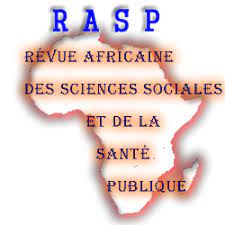Planification des grossesses et pratiques de soins infantiles en Afrique subsaharienne
DOI:
https://doi.org/10.4314/rasp.v7i2.2Mots-clés:
mal planifiées, non désirées, allaitement, soins postnatals, vaccinationRésumé
Cet article s’est fixé pour objectif d’évaluer l’impact de la planification des grossesses sur quatre pratiques de soins infantiles en Afrique subsaharienne que sont l’initiation précoce à l’allaitement, le recours aux soins postnatals, l’allaitement exclusif et la complétude vaccinale. Les dernières données disponibles en 2024 des enquêtes démographiques et de santé de 34 pays d’Afrique subsaharienne couvrant la période de 2011-2022 ont été mobilisées et des méthodes descriptives bivariées et multivariées à travers des régressions logistiques binomiales ont été aussi utilisées pour l’analyse. Les résultats indiquent que les pratiques de santé qui surviennent immédiatement après l’accouchement (initiation à l’allaitement et soins postnatals) sont fortement impactés par la planification des grossesses. En effet, comparativement aux naissances planifiées, celles mal planifiées et non désirées ont respectivement 14,1% et 16,5% moins de chances d’être allaité dans l’heure suivant l’accouchement. Elles ont par ailleurs respectivement 3,9 % et 11,3 % moins de chances de bénéficier de soins postnatals dans les deux jours suivants l’accouchement comparativement aux naissances planifiées. A contrario, les pratiques sanitaires qui surviennent plus tardivement (allaitement exclusif pendant 6 mois, complétude vaccinale) sont faiblement impactées par la planification de la grossesse. Ces résultats indiquent un effet régressif avec le temps de la planification de la grossesse sur les indicateurs de prise en charge sanitaire des enfants en Afrique subsaharienne. Cela peut être mis en relation avec les normes culturelles qui régissent les sociétés africaines ainsi que les liens affectifs qui se développent entre les parents et leurs enfants
Références
Bos, E., & Batson, A. (2000). Using immunization coverage rates for monitoring health sector performance. Washington, DC: The World Bank, 5. https://documents1.worldbank.org/curated/pt/607721468763783070/pdf/288630Bos010Using0Immunization1whole.pdf
Bowlby, J. (1979). The bowlby-ainsworth attachment theory. Behavioral and brain sciences, 2(4), 637‑638. https://www.cambridge.org/core/journals/behavioral-and-brain-sciences/article/bowlbyainsworth-attachment-theory/6D35C7A344107195D97FD7ADAE06C807
Brown, S. S., & Eisenberg, L. (1995). The best intentions : Unintended pregnancy and the well-being of children and families (Institutte of medicine). National Academies Press.
Cheng, D., Schwarz, E. B., Douglas, E., & Horon, I. (2009). Unintended pregnancy and associated maternal preconception, prenatal and postpartum behaviors. Contraception, 79(3), 194‑198. https://pubmed.ncbi.nlm.nih.gov/19185672/
Chinebuah, B., & Pérez-Escamilla, R. (2001). Unplanned pregnancies are associated with less likelihood of prolonged breast-feeding among primiparous women in Ghana. The Journal of nutrition, 131(4), 1247‑1249. https://doi.org/10.1093/jn/131.4.1247
Hajizadeh, M., & Nghiem, S. (2020). Does unwanted pregnancy lead to adverse health and healthcare utilization for mother and child? Evidence from low- and middle-income countries. International Journal of Public Health, 65(4), 457‑468. https://doi.org/10.1007/s00038-020-01358-7
Idang, G. E. (2015). African culture and values. Phronimon, 16(2), 97‑111. http://www.scielo.org.za/scielo.php?script=sci_abstract&pid=S1561-40182015000200006&lng=en&nrm=iso&tlng=en
Joyce, T. J., Kaestner, R., & Korenman, S. (2000). The effect of pregnancy intention on child development. Demography, 37(1), 83‑94. https://pubmed.ncbi.nlm.nih.gov/10748991/
Kanu, M. A. (2010). The indispensability of the basic social values in African tradition : A philosophical appraisal. OGIRISI: a New Journal of African Studies, 7, 149‑161. https://doi.org/10.4314/og.v7i1.57930
Khan, J., Vesel, L., Bahl, R., & Martines, J. C. (2015). Timing of Breastfeeding Initiation and Exclusivity of Breastfeeding During the First Month of Life : Effects on Neonatal Mortality and Morbidity—A Systematic Review and Meta-analysis. Maternal and Child Health Journal, 19(3), 468‑479. https://doi.org/10.1007/s10995-014-1526-8
Kost, K., Landry, D. J., & Darroch, J. E. (1998). The effects of pregnancy planning status on birth outcomes and infant care. Family Planning Perspectives, 30(5), 223‑230. https://doi.org/10.2307/2991608
Kost, K., & Lindberg, L. (2015). Pregnancy intentions, maternal behaviors, and infant health : Investigating relationships with new measures and propensity score analysis. Demography, 52(1), 83‑111. https://doi.org/10.1007/s13524-014-0359-9
Lindberg, L., Maddow-Zimet, I., Kost, K., & Lincoln, A. (2015). Pregnancy intentions and maternal and child health : An analysis of longitudinal data in Oklahoma. Maternal and Child Health Journal, 19(5), 1087‑1096. https://doi.org/10.1007/s10995-014-1609-6
Marston, C., & Cleland, J. (2003). Do unintended pregnancies carried to term lead to adverse outcomes for mother and child? An assessment in five developing countries. Population studies, 57(1), 77‑93. https://doi.org/10.1080/0032472032000061749
Masten, A. S. (2014). Global Perspectives on Resilience in Children and Youth. Child Development, 85(1), 6‑20. https://doi.org/10.1111/cdev.12205
Mohamed, E. A.-E. B., Hamed, A. F., Yousef, F., & Ahmed, E. A. (2019). Prevalence, determinants, and outcomes of unintended pregnancy in Sohag district, Egypt. Journal of the Egyptian Public Health Association, 94(1), 1‑9. https://doi.org/10.1186/s42506-019-0014-9
Oddy, W. H. (2013). Breastfeeding in the first hour of life protects against neonatal mortality. Jornal de Pediatria, 89, 109‑111. https://doi.org/10.1016/j.jped.2013.03.012
Singh, A., Chalasani, S., Koenig, M. A., & Mahapatra, B. (2012). The consequences of unintended births for maternal and child health in India. Population studies, 66(3), 223‑239. https://doi.org/10.1080/00324728.2012.697568
Singh, A., Singh, A., & Mahapatra, B. (2013). The consequences of unintended pregnancy for maternal and child health in rural India : Evidence from prospective data. Maternal and child health journal, 17(3), 493‑500. https://doi.org/10.1007/s10995-012-1023-x
Singh, A., Singh, A., & Thapa, S. (2015). Adverse consequences of unintended pregnancy for maternal and child health in Nepal. Asia Pacific Journal of Public Health, 27(2), NP1481‑NP1491. https://doi.org/10.1177/1010539513498769
Ulep, V. G. T., & Borja, M. P. (2012). Association between pregnancy intention and optimal breastfeeding practices in the Philippines : A cross-sectional study1. BMC Pregnancy and Childbirth, 12(1), 69. https://doi.org/10.1186/1471-2393-12-69
WHO. (2003). Global Strategy for Infant and Young Child Feeding. World Health Organization. https://www.who.int/publications/i/item/9241562218
Downloads
Publiée
Comment citer
Numéro
Rubrique
ARK
Licence
Copyright (c) 2025 Sibiri Clement Ouedraogo, Moussa Bougma

Ce travail est disponible sous la licence Creative Commons Attribution 4.0 International .
https://creativecommons.org/licenses/by/4.0/
You are free to:
- Share — copy and redistribute the material in any medium or format
- Adapt — remix, transform, and build upon the material for any purpose, even commercially.
- The licensor cannot revoke these freedoms as long as you follow the license terms






